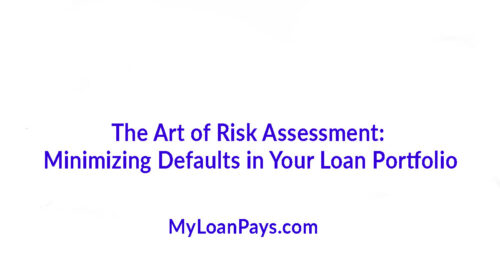Welcome, my curious financial enthusiasts! Today, I’m going to share some wisdom that has been earned through years of navigating the choppy waters of finance. We’ll delve into the intriguing realm of risk assessment and how it plays a pivotal role in ensuring the health of your loan portfolio.
Definition of Risk Assessment
Let’s start with the basics. Risk assessment is like the compass of the financial world. It’s the process of evaluating potential risks and uncertainties that could affect the achievement of your financial goals. In simpler terms, it’s about foreseeing the storms before they hit.
Importance of Risk Assessment in the Financial Industry
Now, why should you care about risk assessment? Well, picture this: you’re sailing a ship through unknown waters. Without a map or a compass, you’re at the mercy of the elements. That’s what it’s like managing finances without proper risk assessment – it’s a recipe for disaster.
Connection between Risk Assessment and Minimizing Defaults
Here’s the secret sauce: by understanding and mitigating risks, you’re essentially building a sturdy ship that can weather any storm. In the financial world, this translates to minimizing defaults in your loan portfolio – a goal every wise investor and lender aims for.
Understanding the Components of Risk
Identifying Different Types of Risks
- Credit Risk: This is the risk that borrowers may fail to repay their loans. Think of it as assessing the reliability of your friend to return the money he borrowed last month.
- Market Risk: Markets can be as unpredictable as the weather. Market risk involves the potential for losses due to fluctuations in interest rates, currency values, or other market factors.
- Operational Risk: Just like a ship can face technical malfunctions, businesses can encounter operational issues. Operational risk involves the potential for loss due to inadequate internal processes, systems, or human errors.
The Impact of Economic Factors on Risk
- Interest Rates: These are like the tides in our financial sea. Understanding how they ebb and flow is crucial for predicting the risk associated with loans.
- Inflation: Inflation is the invisible current beneath the surface. It erodes the purchasing power of money and can affect the profitability of loans.
- Economic Indicators: These are like the constellations in the sky, guiding us to foresee the economic climate. Unemployment rates, GDP, and other indicators help us gauge the health of the economy.
The Role of Data Analytics in Risk Assessment
Utilizing Historical Data
Imagine having a logbook of every storm your ship has weathered. Historical data is your logbook in finance. It helps you identify patterns and anticipate potential risks based on past experiences.
Predictive Modeling for Risk Evaluation
Predictive modeling is like having a weather forecast for your financial journey. By using mathematical models, you can predict potential risks and take preventive measures.
Real-time Monitoring and Adjustments
Just like adjusting sails during a storm, real-time monitoring allows you to make immediate adjustments to your strategies based on the ever-changing financial climate.
Building a Comprehensive Risk Management Strategy
Establishing Risk Tolerance
Every ship has its limits. Similarly, every investor and lender should determine their risk tolerance – the amount of risk they are willing to take on.
Diversification of Loan Portfolio
Diversification is like having different types of ships in your fleet. If one faces a storm, others may sail smoothly, minimizing the impact of defaults.
Stress Testing for Various Scenarios
Stress testing is like preparing your ship for the worst-case scenario. By simulating different economic conditions, you can assess how resilient your portfolio is to potential shocks.
Regular Portfolio Reviews and Adjustments
Think of your portfolio as a garden. Regularly tending to it ensures that you weed out potential risks and foster a healthy, growing environment.
Implementing Technology in Risk Assessment
AI and Machine Learning Applications
These are like having a crew of highly skilled navigators. AI and machine learning can analyze vast amounts of data, providing insights and predictions that human analysis might miss.
Blockchain for Secure Transactions
In the vast sea of finance, blockchain acts as a secure anchor. It ensures transparency and security in transactions, reducing the risk of fraud.
Automation in Risk Evaluation Processes
Automation is like having an efficient crew that handles routine tasks, allowing you to focus on the strategic aspects of risk management.
Regulatory Compliance and Risk Assessment
Overview of Regulatory Standards
Regulatory standards are like the rules of the sea. Understanding and adhering to them is essential for a smooth and lawful financial journey.
Adapting to Changes in Compliance Requirements
Just as the sea can change its rules, so can regulations. Being adaptable and staying informed is key to ensuring ongoing compliance.
The Intersection of Compliance and Effective Risk Management
Compliance is not just a box to tick; it’s intertwined with effective risk management. Meeting regulatory standards often aligns with best practices for risk mitigation.
Training and Skill Development for Risk Management Teams
Importance of a Well-Trained Team
Just as a well-trained crew is essential for a smooth sailing experience, a knowledgeable and skilled risk management team is crucial for navigating the complexities of finance.
Continuous Learning and Adaptation to Industry Trends
The financial sea is ever-changing. Continuous learning and adaptation are the lifebuoys that keep your team afloat in the face of evolving industry trends.
Collaborative Approaches to Risk Assessment
No ship sails alone. Encouraging collaboration among team members fosters a culture of collective responsibility and ensures a comprehensive approach to risk assessment.
The Future of Risk Assessment in the Financial Sector
Emerging Technologies and Their Impact
What new tools are on the horizon? How will emerging technologies reshape the landscape of risk assessment in the financial sector?
Evolving Regulatory Landscape
Just as the sea undergoes changes, so does the regulatory environment. How will these changes shape the future of risk management?
Anticipated Challenges and Opportunities
Navigating the future requires foresight. What challenges and opportunities lie ahead for those who dare to venture into the evolving world of risk assessment?
Conclusion
In the vast and unpredictable sea of finance, mastering the art of risk assessment is your compass, your map, and your anchor. By understanding the currents, anticipating storms, and navigating with wisdom, you can minimize defaults in your loan portfolio. So, my aspiring financial captains, may your sails be ever full, and may your journey be prosperous and secure. Happy sailing!

